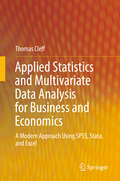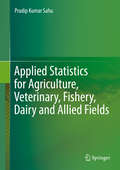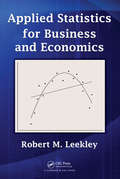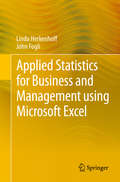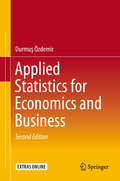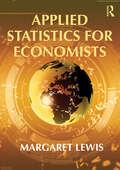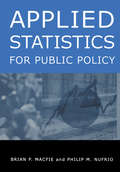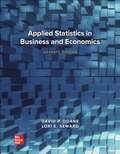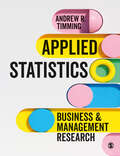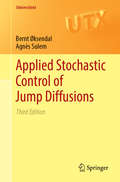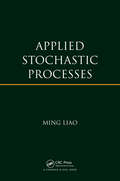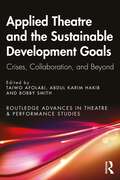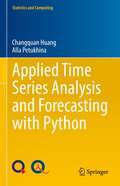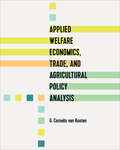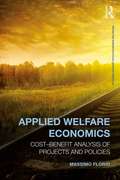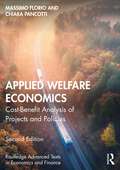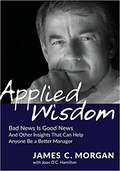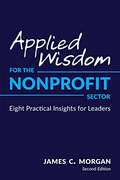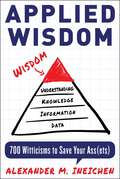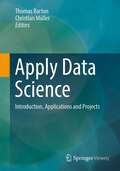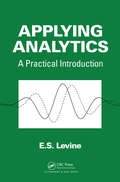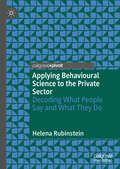- Table View
- List View
Applied Statistics and Multivariate Data Analysis for Business and Economics: A Modern Approach Using SPSS, Stata, and Excel
by Thomas CleffThis textbook will familiarize students in economics and business, as well as practitioners, with the basic principles, techniques, and applications of applied statistics, statistical testing, and multivariate data analysis. Drawing on practical examples from the business world, it demonstrates the methods of univariate, bivariate, and multivariate statistical analysis. The textbook covers a range of topics, from data collection and scaling to the presentation and simple univariate analysis of quantitative data, while also providing advanced analytical procedures for assessing multivariate relationships. Accordingly, it addresses all topics typically covered in university courses on statistics and advanced applied data analysis. In addition, it does not limit itself to presenting applied methods, but also discusses the related use of Excel, SPSS, and Stata.
Applied Statistics for Agriculture, Veterinary, Fishery, Dairy and Allied Fields
by Pradip Kumar SahuThis book is aimed at a wide range of readers who lack confidence in the mathematical and statistical sciences, particularly in the fields of Agriculture, Veterinary, Fishery, Dairy and other related areas. Its goal is to present the subject of statistics and its useful tools in various disciplines in such a manner that, after reading the book, readers will be equipped to apply the statistical tools to extract otherwise hidden information from their data sets with confidence. Starting with the meaning of statistics, the book introduces measures of central tendency, dispersion, association, sampling methods, probability, inference, designs of experiments and many other subjects of interest in a step-by-step and lucid manner. The relevant theories are described in detail, followed by a broad range of real-world worked-out examples, solved either manually or with the help of statistical packages. In closing, the book also includes a chapter on which statistical packages to use, depending on the user's respective requirements.
Applied Statistics for Business and Economics
by Robert M. LeekleyDesigned for a one-semester course, Applied Statistics for Business and Economics offers students in business and the social sciences an effective introduction to some of the most basic and powerful techniques available for understanding their world. Numerous interesting and important examples reflect real-life situations, stimulating students to t
Applied Statistics for Business and Management using Microsoft Excel
by Linda Herkenhoff John FogliApplied Business Statistics for Business and Management using Microsoft Excel is the first book to illustrate the capabilities of Microsoft Excel to teach applied statistics effectively. It is a step-by-step exercise-driven guide for students and practitioners who need to master Excel to solve practical statistical problems in industry. If understanding statistics isn't your strongest suit, you are not especially mathematically-inclined, or if you are wary of computers, this is the right book for you. Excel, a widely available computer program for students and managers, is also an effective teaching and learning tool for quantitative analyses in statistics courses. Its powerful computational ability and graphical functions make learning statistics much easier than in years past. However, Applied Business Statistics for Business and Management capitalizes on these improvements by teaching students and practitioners how to apply Excel to statistical techniques necessary in their courses and workplace. Each chapter explains statistical formulas and directs the reader to use Excel commands to solve specific, easy-to-understand business problems. Practice problems are provided at the end of each chapter with their solutions.
Applied Statistics for Economics and Business
by Durmuş ÖzdemirThis textbook introduces readers to practical statisticalissues by presenting them within the context of real-life economics andbusiness situations. It presents the subject in a non-threatening manner, withan emphasis on concise, easily understandable explanations. It has beendesigned to be accessible and student-friendly and, as an added learningfeature, provides all the relevant data required to complete the accompanyingexercises and computing problems, which are presented at the end of eachchapter. It also discusses index numbers and inequality indices in detail,since these are of particular importance to students and commonly omitted intextbooks. Throughout the text it is assumed that the student has noprior knowledge of statistics. It is aimed primarily at business and economicsundergraduates, providing them with the basic statistical skills necessary forfurther study of their subject. However, students of other disciplines willalso find it relevant.
Applied Statistics for Economists
by Margaret LewisThis book is an undergraduate text that introduces students to commonly-used statistical methods in economics. Using examples based on contemporary economic issues and readily-available data, it not only explains the mechanics of the various methods, it also guides students to connect statistical results to detailed economic interpretations. Because the goal is for students to be able to apply the statistical methods presented, online sources for economic data and directions for performing each task in Excel are also included.
Applied Statistics for Public Policy
by Brian P. Macfie Philip M. NufrioThis practical text provides students with the statistical tools needed to analyze data, and shows how statistics can be used as a tool in making informed, intelligent policy decisions. The authors' approach helps students learn what statistical measures mean and focus on interpreting results, as opposed to memorizing and applying dozens of statistical formulae. The book includes more than 500 end-of-chapter problems, solvable with the easy-to-use Excel spreadsheet application developed by the authors. This template allows students to enter numbers into the appropriate sheet, sit back, and analyze the data. This comprehensive, hands-on textbook requires only a background in high school algebra and has been thoroughly classroom-tested in both undergraduate and graduate level courses. No prior expertise with Excel is required. A disk with the Excel template and the data sets is included with the book, and solutions to the end-of-chapter problems will be provided on the M.E. Sharpe website.
Applied Statistics in Business and Economics
by David P. Doane Lori E. SewardApplied Statistics in Business and Economics, 7th edition, provides real meaning to the use of statistics in the real world by using real business situations and real data while appealing to students who want to know the why rather than just the how. The text emphasizes thinking about data, choosing appropriate analytic tools, using computers effectively, and recognizing the limitations of statistics. It motivates student learning through applied current exercises and cases that provide real-world relevance and includes analytics in action, careers, and applications of big data, Artificial Intelligence, and machine learning (including ethical issues). The Doane and Seward authors work as a team, integrating the digital and eBook assets seamlessly. In recognition of a growing interest in analytics training beyond Excel, the textbook now provides an optional introduction to R with illustrations of topics in each chapter. Support for R is further enhanced with Learning Stats modules, tables of R functions, and R-compatible Excel data sets.
Applied Statistics: Business and Management Research
by Andrew R. TimmingWritten for the non-mathematician and free of unexplained technical jargon, Applied Statistics: Business and Management Research provides a user-friendly introduction to the field of applied statistics and data analysis. Featuring step-by-step explanations of how to carry out successful quantitative research, and supported by examples from IBM® SPSS® Statistics, this textbook is an essential resource for students and researchers of business and management. A range of online resources for both students and lecturers, including a teaching guide, PowerPoint slides and datasets, are available via the companion website. Andrew R. Timming is Professor of Human Resource Management and Deputy Dean Research & Innovation in the School of Management at RMIT University, Australia.
Applied Statistics: Business and Management Research
by Andrew R. TimmingWritten for the non-mathematician and free of unexplained technical jargon, Applied Statistics: Business and Management Research provides a user-friendly introduction to the field of applied statistics and data analysis. Featuring step-by-step explanations of how to carry out successful quantitative research, and supported by examples from IBM® SPSS® Statistics, this textbook is an essential resource for students and researchers of business and management. A range of online resources for both students and lecturers, including a teaching guide, PowerPoint slides and datasets, are available via the companion website. Andrew R. Timming is Professor of Human Resource Management and Deputy Dean Research & Innovation in the School of Management at RMIT University, Australia.
Applied Stochastic Control of Jump Diffusions (Universitext)
by Bernt Øksendal Agnès SulemHere is a rigorous introduction to the most important and useful solution methods of various types of stochastic control problems for jump diffusions and its applications. Discussion includes the dynamic programming method and the maximum principle method, and their relationship. The text emphasises real-world applications, primarily in finance. Results are illustrated by examples, with end-of-chapter exercises including complete solutions. The 2nd edition adds a chapter on optimal control of stochastic partial differential equations driven by Lévy processes, and a new section on optimal stopping with delayed information. Basic knowledge of stochastic analysis, measure theory and partial differential equations is assumed.
Applied Stochastic Processes
by Ming LiaoApplied Stochastic Processes presents a concise, graduate-level treatment of the subject, emphasizing applications and practical computation. It also establishes the complete mathematical theory in an accessible way. After reviewing basic probability, the text covers Poisson processes, renewal processes, discrete- and continuous-time Markov chains,
Applied Strategic Marketing: A Step by Step Approach
by Karel Jan AlsemThis book, originally published in Dutch, provides a uniquely practical approach to strategic marketing planning. Combining a comprehensive overview of theory with practice, each chapter takes the reader step by step through the strategic marketing process. Beginning with identifying the value proposition, it moves on to the situational analysis that underpins the corporate strategy, and finally details the overall implementation and creation of a customer and brand values. Applied Strategic Marketing equips the reader with the necessary tools and techniques to develop and deliver a thorough and effective marketing strategy. With a broad range of international case studies that bring the theory to life, this well-renowned and updated translation is vital reading for undergraduate and postgraduate students of marketing management and strategic marketing. It should also be of interest to marketing practitioners who want a clear overview to aid them in the planning process.
Applied Theatre and the Sustainable Development Goals: Crises, Collaboration, and Beyond (ISSN)
by Bobby Smith Taiwo Afolabi Abdul Karim HakibThis book is the first definitive publication to consider the intersections of applied theatre and the Sustainable Development Goals (SDGs) – a series of goals which have shaped development and social justice initiatives from 2015 to 2030.It brings together emerging and leading scholars and practitioners engaged in creative and community contexts globally. In so doing, the book offers critical insights to explore the convergences, complexities, and tensions of working within development frameworks, through theatre. Divided into three thematic areas, it maps out the ways in which applied theatre has related to the SDGs, examines issues with global collaborations, and, as 2030 approaches and the SDG era draws to a close, interrogates such practices, envisioning what the role of applied theatre might be in the post-SDG era. The book provokes reflection about this specific era of applied theatre and global development, as well as discussion regarding what comes next.This volume will be of importance to students, artists, scholars, practitioners, and policymakers working in applied theatre and the field of development.
Applied Time Series Analysis and Forecasting with Python (Statistics and Computing)
by Changquan Huang Alla PetukhinaThis textbook presents methods and techniques for time series analysis and forecasting and shows how to use Python to implement them and solve data science problems. It covers not only common statistical approaches and time series models, including ARMA, SARIMA, VAR, GARCH and state space and Markov switching models for (non)stationary, multivariate and financial time series, but also modern machine learning procedures and challenges for time series forecasting. Providing an organic combination of the principles of time series analysis and Python programming, it enables the reader to study methods and techniques and practice writing and running Python code at the same time. Its data-driven approach to analyzing and modeling time series data helps new learners to visualize and interpret both the raw data and its computed results. Primarily intended for students of statistics, economics and data science with an undergraduate knowledge of probability and statistics, the book will equally appeal to industry professionals in the fields of artificial intelligence and data science, and anyone interested in using Python to solve time series problems.
Applied Welfare Economics, Trade, and Agricultural Policy Analysis
by G. Cornelis van KootenThis textbook integrates three related fields in economics, namely agricultural/forestry economics, environmental economics, and international trade, by foregrounding cost-benefit analysis as a significant policy tool. Exploring how welfare measures can be used in the analysis of agricultural, trade, and other economic policies, Applied Welfare Economics, Trade, and Agricultural Policy Analysis fills a gap in the literature on agricultural policy analysis by explaining the economic efficiency improvements and income transfers of various agricultural policy reforms in the United States, Canada, and the European Union. G. Cornelis van Kooten addresses methods of identifying and measuring economic surpluses (costs and benefits), the precautionary principle, identification of an appropriate discount rate, the importance of nonmarket values, and the role of agriculture in trade negotiations and climate change. Applied Welfare Economics, Trade, and Agricultural Policy Analysis draws on new research, brings attention to the existing literature, and includes review questions at the end of each chapter. The techniques developed in this text can be applied to the development and reform of agricultural policies in various regions.
Applied Welfare Economics: Cost-Benefit Analysis of Projects and Policies
by Massimo FlorioWhat is the effect of a new infrastructure on the well-being of a local community? Is a tax reform desirable? Does the privatization of a telecommunication provider increase social welfare? To answer these questions governments and their policy advisors should have in mind an operative definition of social welfare, and cannot rely on simple official statistics, such as GDP. The price we observe are often misleading as welfare signals, and costs and benefits for the society should be based on ‘shadow prices’, revealing the social opportunity costs of goods and of changes of the world. This book explains how to apply these welfare economics ideas to the real world. After a theoretical discussion of the concept of social welfare, a critical analysis of the traditional doctrine of welfare economics embodied in the Two Fundamental Theorems, and a presentation of social cost-benefit analysis, the book introduce the readers to an applied framework. This includes the empirical estimation of shadow prices of goods, of the social cost of labour and capital, the assessment of risk. This book also includes the state of the art of international experience with CBA, including ex-post evaluation of major projects, economic rates of return in different sectors, and a case study on privatisation, is presented. This book offers a unique and original blend of theory, empirics and experience. The theoretical discussion clarifies why shadow prices are not virtual market equilibrium prices, as they arise as the solution of a planning problem, often with governments and economic agents constrained in their information and powers. The empirical chapters show how to compute proxies of the shadow prices in simple ways. The experience chapters draw from first hand research, gained by the Author and his collaborators over many years of advisory work for the European Commission and other international and national institutions.
Applied Welfare Economics: Cost-Benefit Analysis of Projects and Policies (Routledge Advanced Texts in Economics and Finance)
by Massimo Florio Chiara PancottiApplied Welfare Economics: Cost-Benefit Analysis for Project and Policy Evaluation presents a consistent framework for applied welfare economics and is grounded in a comprehensive theory of cost-benefit analysis, specifically focused on offering a practical approach to policy and project evaluation. After opening with a theoretical discussion of the concept of social welfare, a critical analysis of the traditional doctrine of welfare economics embodied in the Two Fundamental Theorems, and a presentation of social cost-benefit analysis, the book introduces readers to an applied framework. This includes the empirical estimation of shadow prices of goods, the social cost of labour and capital, and the assessment of risk. The book also examines real-life experiences with cost-benefit analysis, including ex-post evaluation of major projects, economic rates of return in different sectors, and a case study on privatisation. These chapters draw on first-hand research gained by the author team from years of advisory work for the European Commission and other international and national institutions. This second edition presents updated data, more international examples, and more coverage of topics such as very long run discounting effects and climate change as an intergenerational effect. It also includes more practical examples and end-of-chapter questions to aid student’s learning. Applied Welfare Economics is a valuable textbook for upper-level courses on welfare economics, cost-benefit analysis, public policy analysis and related areas.
Applied Wisdom
by James C. MorganSuccess in business demands the effective management of people. James C. Morgan, who for nearly three decades led the high-tech powerhouse Applied Materials Inc. to both financial success and to the designation as one of America's most admired companies and best places to work, provides a simple, straightforward set of principles and tips that he says can help anyone be a better manager. Applied Materials is one of Silicon Valley's great success stories and it helped propel the digital revolution. But Jim Morgan's management techniques are not reserved for high-tech: Applied Wisdom shows how the same approaches, tools, and values work at any scale, from start-ups to middle management in a global corporation ? and even to non-profits. Rich in stories and practical examples, it's a must-read for those seeking a timeless and proven management manual.
Applied Wisdom for the Nonprofit Sector: Eight Practical Insights For Leaders
by James C. MorganFinally, a booklet that integrates the best of business management with the realities of the nonprofit world! While helpful to any reader, the booklet is targeted at those who work in, volunteer with, and support the nonprofit sector. Jim Morgan believes no matter your role in life or job title, anyone can improve their management skills with understanding and practice. He shares his proven leadership insights and management principles through easy-to-remember maxims designed to assist individuals, teams, organizations, networks, and movements to think about and then to apply to complex, real-world situations.
Applied Wisdom: 700 Witticisms to Save Your Assets
by Alexander IneichenApplying wisdom and avoiding foolishness are two sides of the same coin. Slipping away from either can lead to risky and uncertain situations. Luckily, author Alexander Ineichen has been collecting witticisms for thirty-five years that have made him successful in his career and life. In Applied Wisdom, he collects an anthology of wit and wisdom containing over 700 quotations from sources as wide ranging as Thomas Aquinas and Frank Zappa. He provides entertaining food for thought for businesspeople and the general audience alike, and enables readers to think outside the box to find wisdom. These nuggets, along with his commentary for each, are the valuable words needed for those facing risk and uncertainty. The witticisms provide a full range of being level-headed, truth seeking, brutally heretical, wonderfully insightful, refreshingly politically incorrect, and other intellectual treats and provocations. The advice, blending economics, politics, history, philosophy, psychology, risk management, and much more, provides a winning mix of humor, intellectual heft, and economic survival tips.
Applied and Computational Mathematics: ICoMPAC 2023, Sukolilo, Indonesia, September 30 (Springer Proceedings in Mathematics & Statistics #455)
by Dieky Adzkiya Kistosil FahimThis book collects selected, peer-reviewed research presented at the 8th International Conference on Mathematics: Pure, Applied, and Computation, held in Lombok, Indonesia, on 30 September 2023. Organised into three parts—Part I: Control Systems, Mathematical Simulation and Modeling; Part II: Formal Methods and Data Science; Part III: Graph Theory and Analysis—the book contains 29 peer-reviewed chapters. Ranging from theoretical to applied results, the book addresses the mathematical models for several phenomena such as investment behavior, unmanned surface vehicles and electronic medical records. It also highlights the progress in the use of satisfiability methods and tools to solve puzzle and pencil games. It showcases how mathematics is used to solve real-world problems.
Apply Data Science: Introduction, Applications and Projects
by Thomas Barton Christian MüllerThis book offers an introduction to the topic of data science based on the visual processing of data. It deals with ethical considerations in the digital transformation and presents a process framework for the evaluation of technologies. It also explains special features and findings on the failure of data science projects and presents recommendation systems in consideration of current developments. Machine learning functionality in business analytics tools is compared and the use of a process model for data science is shown.The integration of renewable energies using the example of photovoltaic systems, more efficient use of thermal energy, scientific literature evaluation, customer satisfaction in the automotive industry and a framework for the analysis of vehicle data serve as application examples for the concrete use of data science. The book offers important information that is just as relevant for practitioners as for students and teachers.
Applying Analytics: A Practical Introduction
by E. S. LevineNewcomers to quantitative analysis need practical guidance on how to analyze data in the real world yet most introductory books focus on lengthy derivations and justifications instead of practical techniques. Covering the technical and professional skills needed by analysts in the academic, private, and public sectors, Applying Analytics: A Practic
Applying Behavioural Science to the Private Sector: Decoding What People Say and What They Do
by Helena RubinsteinThis book demonstrates how applying behavioural science to commercial problems can effectively help businesses to understand and achieve the best outcomes for their customers. Bringing together theory and practice the author describes how approaches underpinning behavioural science can be adapted to the fast-moving environment of the private sector. The first part of the book discusses the underlying theory and principles behind behavioural science. It outlines the history of the discipline, explaining how behavioural scientists use theories and models of behaviour, and discussing why behaviour is so hard to predict. It then describes how the theory can be applied to designing products, services and interventions. In Part II Rubinstein uses several key case studies to explore the challenges of integrating behavioural science into established practices, considering how to use behavioural science in multidisciplinary teams and why this might be useful. She addresses concerns about the ethics of using behavioural science in this context before describing the value of applying behavioural science to business and how best to realise its potential. This book is a must-read for both practitioners and academics interested in applying the science of behaviour to real-world challenges.
